Comparative review – The Zenith Espada vs. the Grand Seiko Hi-Beat 36000 – WatchTime Wednesday (Specs & price)

Two 3-hand sports watches with a 36.000 vhp are about to fight. In the left corner, representing Switzerland, the Zenith Espada. In the right corner, representing Japan, the Grand Seiko Hi-Beat 36000. Two automatic watches with high-frequency movements square off in a battle of the fast-beat balances. Even if the Zenith Espada El Primero is now discounted, the interest of this comparative review is here to focus on the hi-beat movements made by 2 manufactures that properly master this technology – and together with our colleagues at WatchTime, we’ll be the referees of this fight.
A fast-beat movement offers an advantage over its lower-frequency rivals: more beats per hour means greater precision. The principle is simple: the accuracy with which time can be measured and displayed is inversely proportional to the size of the units into which it is divided. Fast-beat movements are also more shock-resistant than slower-beat ones, and this is an added boon to precision. Two companies make series-produced movements with frequencies of 36,000 vph. One is the ZenithEspada; the other is the Grand Seiko Hi-Beat 36000. We tested one watch from each brand to find out how they measure up against each other in terms of precision and a host of other criteria.
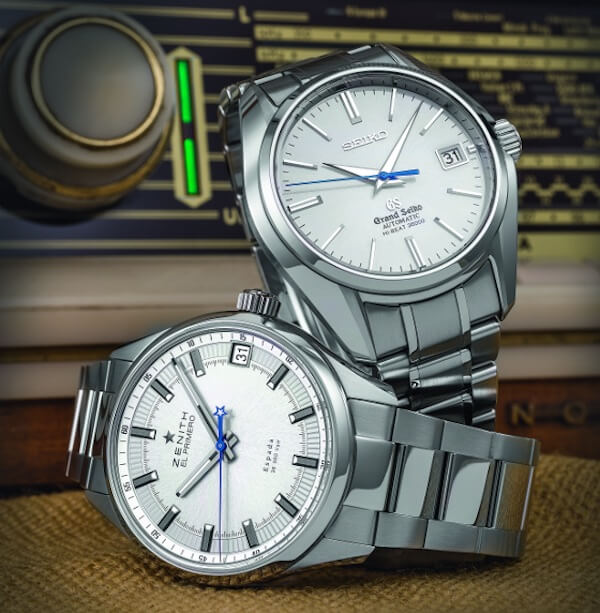
The Zenith Espada, is equipped with a modified version of the company’s celebrated El Primero movement. In its “natural” form, the El Primero is, of course, a chronograph movement. To make the Espada’s movement, a three-hand automatic caliber called the El Primero 4650B, Zenith removed the chronograph mechanism from the El Primero. The Seiko watch, called the Grand Seiko Hi-Beat 36000, contains the automatic Caliber 9S85, introduced in 2009. Both movements required much work to develop. Modifying the El Primero chronograph caliber to power a three-handed watch involved more than merely reducing the number of parts from 280 to 210. The stopwatch mechanism was removed, but it was partly reinstalled afterward. The bridges had to be redesigned and the continually running seconds hand relocated from an off-center subdial to the center of the dial. The resulting construction resembles the classic pattern of a basic caliber in which the central seconds hand is positioned directly within the flow of force rather than drawing its power from a rudiment left over from the chronograph mechanism.
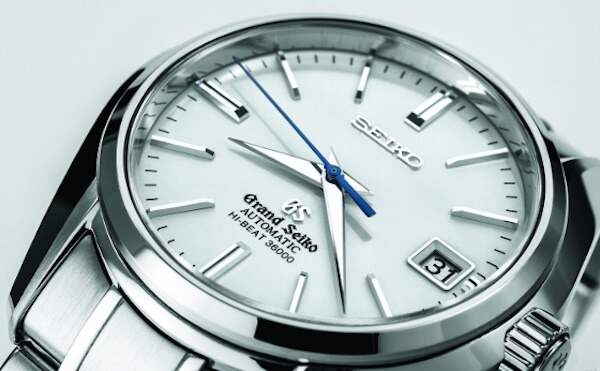
Seiko faced its own challenges. It spent five years developing a special alloy, Spron 610, for its caliber’s hairspring (Seiko makes its own hairsprings and mainsprings). Spron 610 has greater resistance to shocks and magnetism than standard alloys. Because a high frequency puts additional stress on the movement, Seiko redesigned the lever, escape wheel and pallets to increase their longevity. It developed another alloy, Spron 530, for use in the caliber’s mainspring. Spron 530 enables the spring to withstand the stronger torque required by the high-frequency balance: the torque in five-hertz Caliber 9S85 is twice as high as in Seiko’s four-hertz calibers. The spring provides an impressive power reserve of 55 hours.
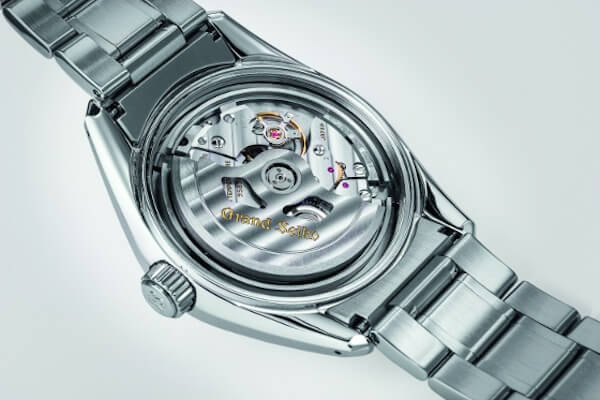
Zenith did not add a stop-seconds function when it modified the El Primero movement. You might ask what the point is of having an extremely precise movement in a plain automatic watch, with no chronograph, if you can’t set the watch with to-the-second accuracy. We tried using an old trick to stop the seconds hand: pulling the crown out to the hand-setting position and then gently turning it counterclockwise. It didn’t work. The seconds hand had so much play that it jumped backward a full five seconds. Seiko’s watch does have a stop-seconds function. El Primero 4650B’s amplitudes are quite low, something you’d be more likely to find in a movement that was carrying the extra burden of powering a chronograph mechanism. This initially led us to suspect that there’s merely a gear train connected to the central seconds hand (formerly the elapsed-seconds hand) from the former off-center seconds hand. But we found this is not the case, so the amplitudes must result from the overall configuration of the movement. However, they don’t hurt the movement’s rate. The amplitudes of Seiko’s Caliber 9S85, on the other hand, are in the usual and expected range.

Both timepieces delivered good rate behavior. Zenith’s model always remained on the “gain” side of zero: it never lost time, and it exhibited this fine performance in all situations: fully wound, after running for 24 hours, and on the wrist. Seiko’s watch ran better, but it strayed into the “minus” column in several positions. It scored a perfect “zero” in the “average daily rate” category when we crunched the numbers, but it lost a bit of time after running for a day – a shortcoming that horological sticklers would find worthy of criticism. On the other hand, we were pleased to see that it ran well in the “plus” column on the wrist. Although the watches aren’t officially certified by COSC, both met not only COSC standards, but the slightly more stringent standards of Seiko’s own Grand Seiko Inspection Standard.
Five screws hold a window of sapphire in the back of the Espada, enabling us to see the new and compact bridge for the automatic-winding mechanism. The mechanism partially obstructed our view of the escapement and the polarizing train for the rotor, which winds the mainspring in both directions of rotation. Although our view was also blocked by the circularly grained bridge, there’s a large bridge beneath it: this construction comes from the former El Primero and covers the entire movement like a three-quarters plate. Stripping El Primero down to serve as a movement for a three-handed watch robs it of its chronograph architecture, but the movement still speaks Zenith’s language, thanks to the brand’s star-shaped logo cut in openwork into the rotor, the fine adjustment via an eccentric screw on an elongated regulator arm and, of course, the fast-paced balance. Seiko’s caliber 9S85 also makes a brand-specific statement behind a screwed-down window of sapphire in its caseback. Seiko fans will recognize the company’s trademark wavy embellishments, similar to Geneva waves, which decorate the bridges, the cocks and the slightly skeletonized rotor. Like the rotor on the Zenith movement, Seiko’s rotor winds the mainspring in both directions of rotation. Seiko uses its well-known Magic Lever pawl indexing system, which it introduced in 1959. The Magic Lever system increases the transfer of power to the mainspring and delivers faster winding speed by harnessing all the energy created by the rotor as it revolves in both directions.
We were disappointed to find that the Magic Lever is hidden from view by the bridge of the movement. Due to the caliber’s bridge construction, you can’t see much more of the 9S85 than you can of Zenith’s movement. Fine adjustment of the balance (which is also manufactured by Seiko) occurs via an eccentric screw (as it does in El Primero), but Seiko’s eccentric screw is paired with a much shorter regulator arm. The name “Grand Seiko” is engraved on the winding rotor in bold letters that are inlaid with gold. When you look at the Grand Seiko’s case, its elegance, functional details and high-quality craftsmanship can be seen from all angles, whether you gaze downward at the steeply sloped and polished bezel, look from the front at the stylized lugs or peer from the side at the arches of the case’s middle section. Like the movement, the case and bracelet are manufactured by Seiko. The processing lavished on the case is especially noteworthy: zaratsu, or “blade polishing,” is accomplished by holding the case against a rotating tin plate at a very precise angle. This creates a mirror finish on both sides of the case, as well as fine bevels on the lugs.
The Grand Seiko’s three-part stainless-steel bracelet is also partly polished and partly matte finished. It is solid but lightweight. It feels supple and harmonizes with the curved middle section of the case to wrap comfortably around its wearer’s wrist. The size differences in the links of the bracelet, which tapers slightly from the lugs to the clasp, add to the harmony. The single-folding clasp closes smoothly. It opens easily when its lateral buttons are pressed. Several links in the bracelet are screwed on either side of the clasp so the bracelet can be easily lengthened or shortened.
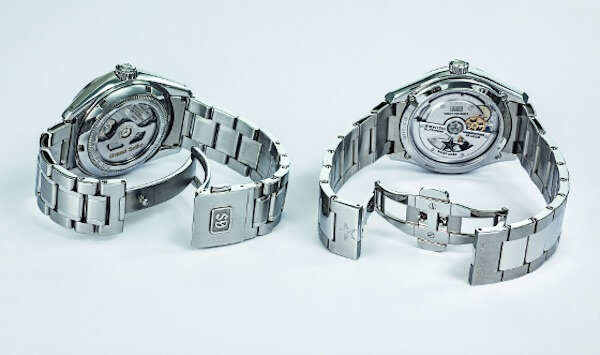
The well-made, stainless-steel bracelet on Zenith’s Espada is just as lightweight, comfortable and convenient to wear as the Seiko bracelet. All of its links are screwed together so it, too, can be easily lengthened or shortened. The clasp is double folding. It is well balanced and opens via buttons on its sides. Zenith’s bracelet is integrated more fully into the case than Seiko’s, although the arching shape of the Zenith case’s middle piece seems a bit truncated. This detail, however, doesn’t detract from the bracelet’s comfort on the wrist. The difference in thickness between the two cases is only about 1.3 mm, but Zenith’s case seems significantly slimmer and larger because its dial is so large: 34 mm in diameter. Except for two matte sections on the lugs, Zenith’s case is brightly polished all over. Zenith’s case design is less stylized than Seiko’s. Each case has a threaded crown and is water resistant to 100 meters.
The Grand Seiko’s crown is integrated slightly into the side of its case. Fluting on the crown’s sides makes it easy to grasp. When the crown is pressed in, it can be turned to wind the mainspring; when pulled out to its first position, it quickly resets the date; and when pulled out to its second position it resets the hands. When the watch is running, the date display gradually advances to show the next day’s date: this change begins around 11 o’clock in the evening and ends when the date numeral jumps ahead at approximately 10 minutes past midnight. El Primero is more than 40 years old, but it has a modern and rapidly switching date display. On the watch we tested, the change from yesterday’s date to today’s took place about three minutes before midnight. In a departure from the norm, the rapid-reset mechanism for El Primero’s date is activated when the crown is pulled to its outermost position. Pressing the crown one notch farther inward – but not all the way in – lets you adjust the hands. The crown has slightly conical fluting and can be screwed shut easily.
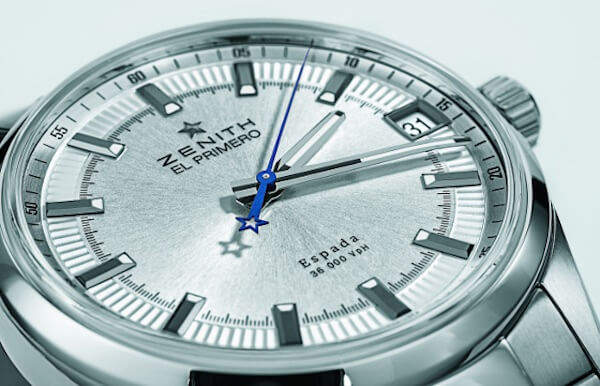
The dials of the two watches are very different, not just in size – the Seiko dial is just 30 mm wide ? but in style. Fluting between the hour indices is the most eye-catching detail on the Espada’s dial. This decorative wreath extends all the way out to the edge of the dial, where it meets the flange. As though they were preserving the memory of the El Primero’s erstwhile stopwatch function, a ring of narrow strokes mark fractions of seconds between adjacent hour indices. This scale consists of four shorter strokes between each adjacent pair of longer strokes so it correctly matches the five-hertz frequency of caliber 4650B. The 11 faceted and rhodium-plated hour indices are meticulously applied atop this same background. Each index’s outer end meets a minutes and seconds scale on the flange; its inner end bears a droplet of Super-LumiNova that glows bright green in the dark. The same green glow shines along the lengths of the hour hand and minutes hand. Legibility is very good in the dark and nearly perfect by day.
The Espada’s sleek hands have a sporty look. The minutes hand is exactly long enough to touch the corresponding scale on the flange; its tip bends downward to minimize potential errors due to parallax. The hour hand has no downward curve at its end and its tip remains close to the 11 appliqués. The narrow seconds hand of blued steel adds a colorful accent. Its shorter end bears Zenith’s star logo. The dial on the Seiko watch is more understated than the Zenith dial. Narrow hour indices rise above a background that’s unobtrusively embellished with a sunburst pattern. Each index slopes downward toward the center of the dial. Neither the indices nor the hands are luminous so the watch can’t be read in the dark. The dial does not provide as much contrast as the Zenith dial does, so it isn’t quite as easy to make out even in daylight. Many shiny surfaces on the applied indices, plus glossy facets along the edges of the hands, tend to reflect sunlight and cause unwanted glare. Like Zenith’s watch, the Grand Seiko has a colorful accent: its narrow blued seconds hand. The dauphine hour and minutes hands end at the inner tips of the indices and the minute strokes, respectively. The latter are neatly marked. All in all, this dial is handsome and consistent, just like the Zenith dial.
How to choose between these two, neck-and-neck watches? Factors to consider start with the price. Even with Seiko’s lofty standards in mind, should a watch lover pay $1,100 more for a high-quality Japanese watch than for an equally fine Swiss timepiece? And if so, what will he get for his money? First, he’ll get a technically modern movement, the latest materials, excellent craftsmanship and, last but not least, the fascination of owning a Grand Seiko. There’s no doubt that an El Primero movement is also a fascinating horological entity, even though the chronograph mechanism has been removed. Perhaps that’s reason enough for a collector to acquire an Espada, which is inspired by the models of the 1970s and pays homage to Zenith’s technical and cultural heritage. From a strictly objective viewpoint, however, we must note that the El Primero 4650B does not reach the high level of Seiko’s caliber 9S85. With the removal of the chronograph mechanism, and without a stop-seconds function, the movement loses the benefits which the chronograph version gained from its fast-paced oscillator.
Pros / Cons
Grand Seiko
Pros
- Modern manufacture caliber
- Good rates
- High-quality craftsmanship
Cons
- Poor nighttime legibility
- Comparatively high price
Zenith
Pros
- Manufacture caliber
- Good rates
- Very good legibility day and night
- High-quality craftsmanship
Cons
- No stop-seconds function
- Low amplitudes
- Too much play in the hands
Specifications
GRAND SEIKO HI-BEAT 36000
- Manufacturer: Morioka Seiko Instruments Inc. 61-1, Itabashi, Shizukuishi-cho, Iwate-gun, Iwate 020-0596, Japa
- Reference number: SBGH001
- Functions: Hours, minutes, seconds; date; stop-seconds function
- Movement: In-house Caliber 9S85, automatic; 36,000 vph, 37 jewels, fine adjustment via index with eccentric screw, Diashock shock absorption, Spron 610 hairspring, bidirectional pawl winding, 55-hour power reserve; diameter = 28.4 mm, height = 5.9 mm
- Case: Stainless steel, domed sapphire crystal is nonreflective on its underside, screwed-down window of sapphire in caseback; water resistant to 100 meters
- Bracelet and clasp: Stainless-steel bracelet with single-folding clasp
- Rate results (Deviation in seconds per 24 hours,when fully wound/after 24 hours):
- Dial up -1.3 / -2.1
- Dial down +1.5 / -0.4
- Crown up -1.0 / -3.5
- Crown down +1.0 / 0.0
- Crown left -0.3 / -2.7
- Greatest deviation of rate 2.8 / 3.5
- Average deviation 0.0 / -1.7
- Average amplitude: Flat positions 318° / 288°- Hanging positions 284° / 267°
- Dimensions: Diameter = 40.65 mm, height = 13.28 mm, weight = 151 g
- Variations: With black dial; special editions in yellow gold, rose gold or white gold ($27,000)
- Price: $7,800
ZENITH EL PRIMERO ESPADA 36,000 VPH
- Manufacturer: Zenith International SA, Rue de Billodes 34-36, CH-2400 Le Locle, Switzerland
- Reference number: 03.2170.4650/01.M2170
- Functions: Hours, minutes, center-mounted seconds hand; date
- Movement: In-house El Primero 4650B, automatic; 36,000 vph, 22 jewels, fine adjustment via eccentric screws, Kif shock absorption, bidirectional winding, Nivarox hairspring, Glucydur balance, 50-hour power reserve; diameter = 30.0 mm, height = 5.58 mm
- Case: Stainless steel, domed sapphire crystal with nonreflective coating, caseback with screwed-down sapphire window; water resistant to 100 meters
- Bracelet and clasp: Stainless-steel bracelet with double-folding clasp
- Rate results (Deviation in seconds per 24 hours, when fully wound/after 24 hours):
- Dial up +5.0 / +4.8
- Dial down +2.8 / +2.4
- Crown up +3.0 / +0.5
- Crown down +6.0 / +7.2
- Crown left +3.9 / +1.7
- Greatest deviation of rate 3.2 / 6.7
- Average deviation +4.1 / +3.3
- Average amplitude: Flat positions 282° / 257° – Hanging positions 250° / 229°
- Dimensions: Diameter = 40.37 mm, height = 11.96 mm, weight = 141 g
- Variations: With black, white or brown sunray or mother-of-pearl dial, rose-gold case on strap, steel and gold case and bracelet, rose-gold case and bracelet, set with diamonds ($6,700 – $29,100)
- Price: $6,700
This article, written by Martina Richter, with photos by Zuckerfabrik Fotodesign, was first published by WatchTime and republished here with authorization.




3 responses
No hacking seconds on the Zenith? That’s a fatal error right there, no need to continue with the rest of the review!!!
No hacking second is an epic fail… 🙁
However, Espada looks pretty.
Can only agree with the above. No hacking seconds on a watch of this price/status is a shocker. I’ll can live with it on my Orient Three Star for $100.
I also think the review shows a little bias when “should a watch lover pay $1,100 more for a high-quality Japanese watch?” is asked. Why not? A Grand Seiko (let alone Seiko’s Credor models) is every bit as good and possibly superior to “equivalent” Swiss watches.